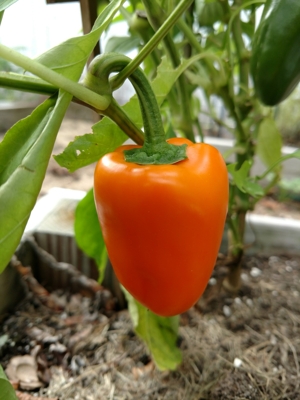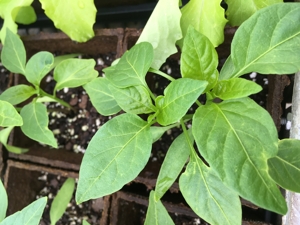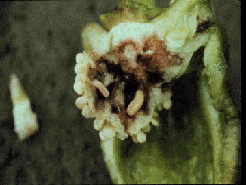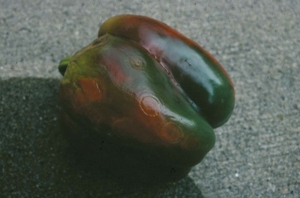Peppers
Capsicum sp.

Peppers are in the genus Capsicum in the group of flowering plants in the nightshade family Solanaceae. Other members of this family include tomatoes, potatoes, eggplant, and tobacco. They are native to the Americas and have been cultivated for hundreds of years. In Connecticut peppers are a frost-sensitive annual vegetable plant that may present some difficulties. The most common species for home gardens is Capsicum annuum which encompass the bell pepper, cayenne, jalapeno, paprika, serrano, and sweet pepper. C. chinense, a species of chili peppers, includes the habanero, Scotch bonnet, Trinidad scorpion, and other hot peppers.
Soil Requirements
Peppers should be planted in full sun, 6-8 hours per day, and require deeply worked, well-drained soil that has a lot of organic matter. They prefer a pH between 6.0 and 6.8 although they will tolerate a pH as low as 5.5. A soil test from the UConn Soil Analysis Lab will help determine the pH and will give amendment suggestions. Testing and changes should be made in the fall prior to the current growing year so that changes may take effect. Peppers do best in soil that is consistently moist but well-drained. Consider planting in raised beds if soggy soil is an ongoing issue. See Vegetable Garden Basics and Plant Selections for additional information.
Planting
When possible, do not plant peppers in a spot where tomatoes, eggplant, potatoes, peppers, or tobacco have been planted within the past three years. Separate these plants as much as possible in the garden and remove or till under all plant residue at the end of the season to reduce overwintering pests or diseases. Members of this plant family can also be planted in deck or patio containers that may be sterilized at the end of each growing season.

Pepper seedlings image by Carol Quish
Purchase healthy disease-resistant varieties when possible. Pepper seeds may be started indoors 8-10 weeks before transplanting but wait until the soil temperatures reach 65°F before transplanting outdoors (Seed Starting). Direct sown seeds will not germinate in soil below 55°F. Black plastic and row covers may be used to warm the soil but row covers should be removed once plants blossoms are forming as the area under the covers may overheat the plants and cause the blossoms to drop. Nighttime temperature that go above 75°F or below 60°F will inhibit fruit set as will daytime temperatures above 90°F. Even daytime temperatures in the high 80s during fruit set may affect them.Some pepper plant varieties may grow up to 3’ so stake tall varieties of plants. Don’t let fruit touch the ground.
Water
Peppers require 1-2” of water per week. After the soil temperatures have warmed to 70°F apply mulch to prevent weeds, reduce soil borne diseases, suppress weed growth, and retain moisture (this will help control Blossom end rot).
Fertilizer Needs
Peppers use phosphorous and potassium for blossoms and fruit. High nitrogen will promote leafy growth but lower fruit yield. Use a fertilizer with a 1-2-1 or 1-2-2 ratio according to your soil test results. See Suggested Fertilizer Practices for Vegetables and Herbs.
Harvesting
Green peppers are actually immature fruit but can be picked when they are 3-4” long and firm. Fruit allowed to stay on the plant will ripen to yellow, orange, red, purple, or chocolate brown. Plant a second row if you want to have both green and mature fruit. Remove or till under all plant debris at the end of the season. Do not compost diseased plant tissues.
Insect Pests

Pepper maggot image by Jude Boucher
- Commonly found on pepper plants are melon or green peach aphids which can vector diseases. See the UConn IPM factsheet Aphids and Viruses.
- Other pests include flea beetle, tarnished plant bug, stink bugs, spider mites, thrips, and European corn borer.
- Pepper maggot.
- Scouting, hand-picking, and low-toxicity insecticides can control many pests.
Diseases

Ring spot image by Jude Boucher
- Sanitation is key to controlling the spread of disease.
- If possible, peppers should not be planted in the same spot as tomatoes, eggplant, and potatoes for 3-4 years especially if disease was present.
- Cucumber mosaic virus appears as ring spots or necrotic tissue and can be vectored by aphid feeding. Use Horticultural oil or mineral oil to control aphids.
- Tobacco mosaic virus is less of a problem as there are resistant species but can be transmitted by people that also handle tobacco.
- Septoria leaf spot, Anthracnose, and to a lesser extent early blight are fungal diseases that infect pepper.
- Phytophthora capsici is a fungal disease that rots all parts of the pepper plant: roots, stem, crown, and fruit. It will even survive on or in infected seed.
- Bacterial spot is caused by the bacterium Xanthomonas campestris pv. vesicatoria and presents itself as sunken brown tissue on the upper surface of leaves and raised bumps on fruit.
- Fusarium wilt and Verticillium wilt are common root diseases caused by fungi. Because of soil-borne spores, an important control of these diseases is rotation of plantings of peppers and their close relatives.
- Removal and destruction of infected crop residues and cultural methods that promote rapid drying of wet foliage are also important for control of foliage diseases.
- See the UConn IPM factsheet Minor Diseases of Pepper for additional information.
Pepper Varieties
Bell
| Variety | Harvest | Description | Disease Resistance |
| Bell Boy | 70 days | Hybrid, sweet bell. Plants bear 5" by 4 3/4", thick-fleshed fruit. Goes from green to red. |
Resistant to bacterial leaf spot. |
| Boynton Bell | 75 days | Hybrid, sweet bell. Plants bear extra-large, thick-walled, green fruit maturing to red. |
Resistant to bacterial leaf spot. |
| Chablis | 60 days | Sweet bell. 1 1/2' tall. Early maturing plants produce blocky, 4" by 3" thick-walled fruit. White to orange to scarlet. | Resistant to tobacco mosaic virus and bacterial leaf spot. |
| Chocolate Bell | 75 days | Sweet bell. Plants bear 4 1/2" by 4" smoky-flavored fruit maturing from green to chocolate brown. | Resistant to tobacco mosaic virus. |
| Cute Stuff Red | 62 days | Mini bell pepper. Plants produce 2" to 3" green to red fruit. Suitable for container or field garden. | |
| Golden Bell | 68-70 days | Sweet bell. Plants bear 3 or 4-lobed, blocky, thick-walled, light-green fruit maturing to deep gold. | |
| Gypsy | 65 days | Sweet bell. Medium-sized plants bear 3" to 5", wedge-shaped, yellow fruit that holds color. Produces well in both cool and hot regions. All American Selection 1981. | Resistant to tobacco mosaic virus. |
| Islander | 56-81 days | Sweet bell. Plants bear medium-sized, 3-lobed, thick-fleshed, mild, lavender fruit at 56 days then maturing to violet to yellow to orange-streaked and finally rich dark red at 81 days. | Resistant to tobacco mosaic virus. |
| King Arthur | 60-80 days | Sweet bell. Dwarf plants bear 3 or 4-lobed, 5", square, green fruit maturing to red. | Resistant to multiple viruses: tobacco mosaic, potato Y, tobacco etch. Also bacterial leaf spot. |
| Labrador | 60-80 days | Sweet bell. Compact plants bear medium to large, blocky, fruity, green fruit at 60 days turning yellow at 80 days. Ripe fruit holds well. | Resistant to tobacco mosaic virus and potato virus Y. |
| Lady Bell | 72 days | Sweet bell. Plants bear green fruit maturing to red. | Resistant to tobacco mosaic virus. |
| New Ace | 55-65 days | Sweet bell. Plants bear 3 or 4-lobed, thick-walled fruit that holds its green color. Plants set fruit well in cool weather and resist blossom drop. Fruit does not sunburn easily. | Resistant to tobacco mosaic virus. |
| Parks Early Thickset Hybrid | 45 days | Sweet bell. 5" by 4", 3 to 4-lobed with 1/2" thick walls that turn from glossy green to bright red when mature. Suitable for salads, stuffing, frying or freezing. Harvest 2 to 3 weeks earlier than most other big bells. | Resistant to Tobacco Mosaic Virus. |
| Purple Belle | 70 days | Sweet bell. Plants bear mostly 4-lobed, blocky, thick-walled fruit that ripen from green to deep purple, then red at full maturity. Also known as 'Purple Bell'. | |
| Red Knight X3R | 57-77 days | Sweet bell. Compact plants bear big, blocky, thick-walled, green fruit at 57 days maturing to red. | Resistant to bacterial leaf spot, potato virus Y and tobacco mosaic virus. |
| Sweet Chocolate | 58 days | Sweet bell. Plants bear smooth, medium-sized, 2 1/2" by 4", mild, snub-nosed, green fruit at 58 days maturing to brown with thick red flesh. Heavy fruit set and tolerant of cool nights. |
Sweet, Frying, or Salad Type
| Banana Supreme | 68 days | Sweet frying. Plants bear 7" to 8", green-yellow fruit maturing to yellow then red. | Good disease resistance. |
| California Wonder 300 | 65 days | Sweet pepper. Leafy plants produce 4 or 5, 4-lobed, thick-walled, blocky, green fruit that ripen to red. Good for cool growing conditions. | Resistant to tobacco mosaic virus. |
| Cubanelle | 65-80 days | Sweet frying. Plants bear 2" by 6", elongated, waxy, yellowish-green fruit changing to orange-red. Walls are not particularly thick. | |
| Gypsy | 65 days | Sweet bell/frying hybrid. Medium-sized plants bear 3" to 5" wedge-shaped, yellow fruit that holds color. Produces well in both cool and hot regions. All American Selection 1981. | Resistant to tobacco mosaic virus. |
| Italian Frying | 50 days | Early sweet frying. Plants bear long, shiny green fruit that ripen to red. | |
| Snapper | 62-82 days | Sweet pepper hybrid. Plants bear blocky, 3- to 4-lobed, green fruit that ripen to red. | Resistant to bacterial leaf spot 1, 2, & 3, pepper mottle virus, tobacco etch virus and tobacco mosaic virus. |
| Spanish Spice | 63-68 days | Hybrid sweet/hot frying. Upright plants bear 7" tapered, thin-walled, green fruit maturing to red. | Resistant to tobacco mosaic virus. |
| Sweet Banana | 70 days | Sweet Hungarian. Plants bear 6-inch, yellow fruit maturing to crimson on highly productive plant. |
Hot Peppers
| Variety | Harvest | Description | Disease Resistance |
| Andy | 60-85 days | Hybrid hot cayenne. Plants bear uniform 7" to 8" by 3/4" straight, green fruit at 60 days maturing to bright red. Strong erect plants hold fruit up. | Resistant to tobacco mosaic virus. |
| Cayenne, large thick | 70 days | Hot cayenne. Plants bear thin, 4" to 5" fruit that ripen to red. | |
| Cayenne, long slim |
73 days | Hot cayenne. Plants bear 5" to 6" curved, wrinkled, fiery-hot fruit that starts waxy green and matures to crimson. Excellent for drying. Also known as 'Long Red Cayenne', 'Red Cayenne', 'Cayenne Long Thin', and 'Cayenne Long Slim'. | |
| Colima | 65 days | Jalapeño hybrid. Plants reaching up to 28" in height produce 4" long, tapered, medium green, thin walled and crack resistant fruits. | Resistance to bacterial spot, tobacco mosaic virus and potato Y virus. |
| Golden Greek | 60 days | Hot pepperoncini. Plants bear 4" by 1" mildly hot, slightly tapered, blunt-nosed, thin walled, light greenish-yellow fruit. Also known as 'Golden Greek Pepperoncini' and 'Tasty Golden Greek'. | |
| Habanero | 75-100 days | Plants bear 1 1/2" by 3" very wrinkled, very hot, dark-green fruit at 75 days maturing to salmon-orange. Extremely hot. | |
| Hungarian Yellow Wax | 58-85 days | Medium-hot pepper. 16" to 24" everbearing plants bear medium-thick-walled, 6" by 1 1/2" tapered, waxy yellow fruit ripening to crimson. Becomes hotter and redder as they mature. Good for cool areas. | |
| Jalapeno | 70 days | Hot jalapeno. Upright plants bear hot, 3 1/2" deep-green fruit. | |
| Mariachi | 65-68 days | Hybrid chili, mildly hot (500 to 600 Scoville units). 18" to 24" plants bear cone-shaped, fleshy, 3" to 4" fruit that ripens from yellow to red (though usually harvested when yellow). Fruit can become more pungent when stressed. 2006 All America Selection. | Resistant to tobacco mosaic virus. |
| Mucho Nacho | 69-70 days | Hybrid hot jalapeno. Vigorous plants bear 4" green fruit maturing to red. Hotter than other jalapenos. | Resistant to potato virus Y and tobacco etch virus. |
| Red Chili | 84 days | Hot pepper. 20" plants bear 1 1/2" deep red fruit. Very hot and good for drying. | |
| Senorita | 60 days | Hybrid hot jalapeno. 28" plants bear 3" by 1 1/2" mild, green fruit maturing to red. | Resistant to tobacco etch, pepper mottle and potato Y viruses. |
| Serrano Del Sol | 55-75 days | Hybrid hot serrano. 2 1/2' to 3' plants bear 3" to 3 1/2" very hot, cylindrical, green fruit at 55 days maturing quickly to dark scarlet. Usually eaten as fresh green, rarely dried. | Resistant to tobacco mosaic, tobacco etch, potato Y and pepper mosaic. |
| Super Chile | 50-75 days | Hybrid hot/ornamental pepper. Short spreading plants bear 2 1/2" by 1/2" upright, super-hot, pointed, light-green fruit maturing to orange and then to red. All-American Selection 1988. Also known as Super Chili. |
Despite good cultural practices, pests and diseases at times may appear. Chemical control should be used only after all other methods have failed.
For pesticide information or other questions please call toll free: 877-486-6271.
UConn Home and Garden Education Center, 2017
Issued in furtherance of Cooperative Extension work, Acts of May 8 and June 30, 1914, in cooperation with the U.S. Department of Agriculture, the Dean of the College, Cooperative Extension System, University of Connecticut, Storrs. The Connecticut Cooperative Extension System is an equal opportunity employer and program provider. To file a complaint of discrimination, write USDA, Director, Office of Civil Rights, Room 326-W, Whitten Building, Stop Code 9410, 1400 Independence Avenue, SW, Washington, DC 20250-9410 or call (202) 720-5964.